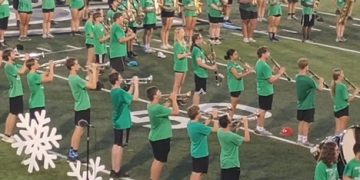By Barry Bernhardt
Greetings from Lake St. Louis, MO! By now, you have all had at least one performance at a football game or sporting event and possibly even a marching contest performance or parade. The big question is, what now? There are many important questions you should be asking yourself and here are some of my solutions.
Is my band playing with a good characteristic sound and are they in tune?
We all would hope our bands are playing with good tone, balance and blend. Generally, at this time of year, we have been playing together for over two months. With the demand of getting drill on the field and cleaning the show, we often forget about how we sound. Don’t forget music fundamentals.
Make sure you are using some breathing/stretching exercises every single day. I have always had great success using Breathing Gym, by Patrick Sheridan. Many times, I do Breathing Gym along with my visual/marching block. By doing this you encourage your students to be able to multi-task. That’s how they succeed!
I follow that block of rehearsal with solid horn warmups. Have the woodwinds play an F Remington exercise while the brass buzz mouthpieces. I follow this by combining all winds playing the F Remington exercise. I continue by having the woodwinds play BH Remington while the brass buzz mouthpieces only. Then the full ensemble plays the Bb Remington. Keep in mind the winds should only play at a volume level 5 out of 10 throughout.
I follow that sequence with a tuning exercise using a BH Scale in the round; lows, mids, highs entering the sequence every 8 counts, not repeating the top note then holding the low BH when you arrive. Good sound is good sound is good sound.
I have judged marching bands all over the country for over 40 years. I always enjoy being the music judge. Remember it is band first and marching second! I firmly believe the time spent on producing a good, well-balanced sound will pay off in the end.
Is my drill clean? Does it need revisions?
If you have a competitive band and you have your show on the field, my suggestion is to start cleaning from the end of the show. So many times, as we tend to do in concert band/wind ensemble season, we rehearse the beginning of a tune every time we rehearse it. The beginning will be good, the middle will be average, and the end will be below average. Rehearse in reverse.
I have always used the following method to teach and subsequently clean drill. For practical purposes let’s say we are working on the closer. Play the first music cue in the position for page 1; (example: bar 1 to bar 8). Follow that by marching and singing page 1 to page 2. Check and adjust. Repeat. Then march and play that first music cue/drill movement. I would suggest you do at least two full passes of the cue. Then, rinse and repeat for the next music cue.
Once you are happy with the second music cue, then start at page 1 and run pages 1 and 2 together. Again, rinse and repeat. While this method does take patience and time, consistency will pay off without question. Make a goal to clean one portion of the show per rehearsal and end each rehearsal with at least one, but preferably two full-runs of what you have cleaned up to that point. I would also suggest you try to play the music for the next rehearsal at some point during your music block.
Also, during the cleaning of drill sets, I would suggest breaking down each visual enhancement of the show. I was visiting Ft. Zumwalt North High School Marching Band the other evening and they were cleaning not only drill sets/transitions, but also their visual package. I would say a similar approach to drill cleaning should be used here as well.
For best results, I encourage you to learn visual moves in small chunks, adding another music cue each rep or so. This promotes good coordination of elements. If your band is advanced, you may be able to clean music cues, drill move, and visuals all at once. Kudos if you can do that much.
If some of my drill sets and/or transitions now seem awkward, now is the time to adjust. Don’t wait until the very last moment to adjust your show. There is always that “one” drill move or transition that works well on paper, but it is and always will be awkward and difficult to clean. Make your adjustments right away. You can thank me later….
Does my band sell the visual package?
All visual enhancements, commonly known as VIS, need the same attention to detail as all other previous elements. By breaking down each visual enhancement in smaller components, adding 4-8 counts at a time, you will be visually cleaner. Again, this all takes time, but the payoff is HUGE!
BarryWBe@gmail.com































